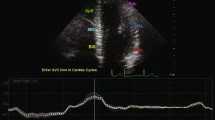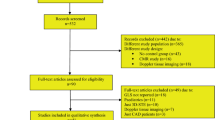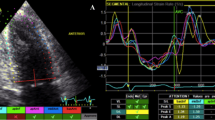Abstract
Cardiac time intervals (CTI) are prognostic above and beyond conventional echocardiographic measures. The explanation may be that CTI contain information about both systolic and diastolic measures; this is, however, unknown. The relationship between the CTI and systolic and diastolic function assessed by conventional, tissue Doppler (TDI) and speckle-tracking echocardiography (STE) was investigated. CTI and echocardiographic measurements, including conventional, STE, and TDI echocardiography, were studied in 1088 type 1 diabetes patients without known heart disease randomly selected from the out-patient clinic at Steno Diabetes Center. The CTI were obtained by TDI M-mode through the mitral leaflet and included the isovolumic relaxation time (IVRT), isovolumic contraction time (IVCT), and the myocardial performance index (MPI = (IVRT + IVCT)/ejection time). Standardized beta-values were assessed. Both systolic and diastolic measures associated with CTI. Conventional measures: left ventricular ejection fraction (stand. beta): MPI −0.34, IVRT 0.24, and IVCT −0.21, all p < 0.001. For the TDI measures, the most significant association was found with e′: MPI (stand. beta: −0.30, p < 0.001) and IVRT (−0.35, p < 0.001) but no association with IVCT −0.05, p = 0.1). Speckle-tracking derived measures were in general strongly associated with the cardiac time intervals. Thus, global longitudinal strain and MPI (−0.38, p < 0.001), IVRT (−0.23, p < 0.001), and IVCT (−0.10, p < 0.001); and global longitudinal strain rate e and MPI (−0.40, p < 0.001), IVRT (−0.42, p < 0.001), and IVCT (−0.04, p = 0.11). CTI, in particular MPI and IVRT, associate with both systolic and diastolic myocardial function assessed by conventional and newer echocardiographic measures. This may possibly help to explain the prognostic significance of CTI.


Similar content being viewed by others
References
Garrod AH (1874) On some points connected with circulation of the blood arrived at from a study of the sphygmograph. Proc R Soc Lond 23:140
Bowen WP (1904) Changes in heart rate, blood pressure and duration of systole from bicycling. Am J Physiol 11:59
Lombard WP, Cope OM (1926) Duration of the systole of the left ventricle of man. Am J Physiol 77:263
Katz LN, Feil HS (1923) Clinicalobservations on the dynamics of ventricular systole: I. Auricular fibrillation. Arch Intern Med 32:672
Weissler AM, Harris WS, Schoenfeld CD (1968) Systolic time intervals in heart failure in man. Circulation 37:149–159
Mancini GB, Costello D, Bhargava V et al (1982) The isovolumic index: a new noninvasive approach to the assessment of left ventricular function in man. Am J Cardiol 50:1401–1408
Tei C (1995) New non-invasive index for combined systolic and diastolic ventricular function. J Cardiol 26:135–136
Tei C, Dujardin KS, Hodge DO et al (1996) Doppler index combining systolic and diastolic myocardial performance: clinical value in cardiac amyloidosis. J Am Coll Cardiol 28:658–664
Tei C, Ling LH, Hodge DO et al (1995) New index of combined systolic and diastolic myocardial performance: a simple and reproducible measure of cardiac function—a study in normals and dilated cardiomyopathy. J Cardiol 26:357–366
Tekten T, Onbasili AO, Ceyhan C et al (2003) Novel approach to measure myocardial performance index: pulsed-wave tissue Doppler echocardiography. Echocardiogry 20:503–510
Tekten T, Onbasili AO, Ceyhan C et al (2003) Value of measuring myocardial performance index by tissue Doppler echocardiography in normal and diseased heart. Jpn Heart J 44:403–416
Harada K, Tamura M, Toyono M et al (2001) Assessment of global left ventricular function by tissue Doppler imaging. Am J Cardiol 88(927–932):A9
Voigt J-U, Lindenmeier G, Exner B et al (2003) Incidence and characteristics of segmental postsystolic longitudinal shortening in normal, acutely ischemic, and scarred myocardium. J Am Soc Echocardiogr Off Publ Am Soc Echocardiogr 16:415–423
Kjaergaard J, Hassager C, Oh JK et al (2005) Measurement of cardiac time intervals by Doppler tissue M-mode imaging of the anterior mitral leaflet. J Am Soc Echocardiogr Off Publ Am Soc Echocardiogr 18:1058–1065. doi:10.1016/j.echo.2005.03.043
Biering-Sørensen T, Mogelvang R, Pedersen S et al (2011) Usefulness of the myocardial performance index determined by tissue Doppler imaging m-mode for predicting mortality in the general population. Am J Cardiol 107:478–483. doi:10.1016/j.amjcard.2010.09.044
Biering-Sørensen T, Mogelvang R, Jensen JS (2015) Prognostic value of cardiac time intervals measured by tissue Doppler imaging M-mode in the general population. Heart Br Card Soc 101:954–960. doi:10.1136/heartjnl-2014-307137
Biering-Sørensen T, Mogelvang R, Søgaard P et al (2013) Prognostic value of cardiac time intervals by tissue Doppler imaging M-mode in patients with acute ST-segment-elevation myocardial infarction treated with primary percutaneous coronary intervention. Circ Cardiovasc Imaging 6:457–465. doi:10.1161/CIRCIMAGING.112.000230
Jensen MT, Sogaard P, Andersen HU et al (2015) Global longitudinal strain is not impaired in type 1 diabetes patients without albuminuria. JACC Cardiovasc Imaging 8:400–410. doi:10.1016/j.jcmg.2014.12.020
Jensen MT, Sogaard P, Andersen HU et al (2014) Prevalence of systolic and diastolic dysfunction in patients with type 1 diabetes without known heart disease: the Thousand & 1 Study. Diabetologia 57:672–680. doi:10.1007/s00125-014-3164-5
Lang RM, Bierig M, Devereux RB et al (2005) Recommendations for chamber quantification: a report from the American Society of Echocardiography’s Guidelines and Standards Committee and the Chamber Quantification Writing Group, developed in conjunction with the European Association of Echocardiography, a branch of the European Society of Cardiology. J Am Soc Echocardiogr 18:1440–1463. doi:10.1016/j.echo.2005.10.005
Nagueh SF, Appleton CP, Gillebert TC et al (2009) Recommendations for the evaluation of left ventricular diastolic function by echocardiography. Eur J Echocardiogr 10:165–193. doi:10.1093/ejechocard/jep007
Kasner M, Westermann D, Steendijk P et al (2007) Utility of Doppler echocardiography and tissue Doppler imaging in the estimation of diastolic function in heart failure with normal ejection fraction: a comparative Doppler-conductance catheterization study. Circulation 116:637–647. doi:10.1161/CIRCULATIONAHA.106.661983
Gaibazzi N, Petrucci N, Ziacchi V (2005) Left ventricle myocardial performance index derived either by conventional method or mitral annulus tissue-Doppler: a comparison study in healthy subjects and subjects with heart failure. J Am Soc Echocardiogr 18:1270–1276. doi:10.1016/j.echo.2005.06.006
Duzenli MA, Ozdemir K, Aygul N et al (2009) Comparison of myocardial performance index obtained either by conventional echocardiography or tissue Doppler echocardiography in healthy subjects and patients with heart failure. Heart Vessels 24:8–15. doi:10.1007/s00380-008-1069-2
Bruch C, Schmermund A, Marin D et al (2000) Tei-index in patients with mild-to-moderate congestive heart failure. Eur Heart J 21:1888–1895. doi:10.1053/euhj.2000.2246
Carluccio E, Biagioli P, Alunni G et al (2012) Improvement of myocardial performance (Tei) index closely reflects intrinsic improvement of cardiac function: assessment in revascularized hibernating myocardium. Echocardiogry 29:298–306. doi:10.1111/j.1540-8175.2011.01575.x
Su H-M, Lin T-H, Voon W-C et al (2007) Correlation of Tei index obtained from tissue Doppler echocardiography with invasive measurements of left ventricular performance. Echocardiogry 24:252–257. doi:10.1111/j.1540-8175.2007.00382.x
Uemura K, Kawada T, Zheng C et al (2013) Myocardial performance index is sensitive to changes in cardiac contractility, but is also affected by vascular load condition. Conf Proc Annu Int Conf IEEE Eng Med Biol Soc IEEE Eng Med Biol Soc Conf 2013:695–698. doi:10.1109/EMBC.2013.6609595
Kraigher-Krainer E, Shah AM, Gupta DK et al (2014) Impaired systolic function by strain imaging in heart failure with preserved ejection fraction. J Am Coll Cardiol 63:447–456. doi:10.1016/j.jacc.2013.09.052
Biering-Sørensen T, Mogelvang R, Schnohr P, Jensen JS (in press) Cardiac time intervals measured by tissue doppler imaging M-mode: association with hypertension, left ventricular geometry, and future ischemic cardiovascular diseases. J Am Heart Assoc
Gorcsan J 3rd, Tanaka H (2011) Echocardiographic assessment of myocardial strain. J Am Coll Cardiol 58:1401–1413. doi:10.1016/j.jacc.2011.06.038
Ersbøll M, Valeur N, Mogensen UM et al (2013) Prediction of all-cause mortality and heart failure admissions from global left ventricular longitudinal strain in patients with acute myocardial infarction and preserved left ventricular ejection fraction. J Am Coll Cardiol 61:2365–2373. doi:10.1016/j.jacc.2013.02.061
Ersbøll M, Andersen MJ, Valeur N et al (2014) Early diastolic strain rate in relation to systolic and diastolic function and prognosis in acute myocardial infarction: a two-dimensional speckle-tracking study. Eur Heart J 35:648–656. doi:10.1093/eurheartj/eht179
Cui W, Roberson DA, Chen Z et al (2008) Systolic and diastolic time intervals measured from Doppler tissue imaging: normal values and Z-score tables, and effects of age, heart rate, and body surface area. J Am Soc Echocardiogr 21:361–370. doi:10.1016/j.echo.2007.05.034
Bruch C, Schmermund A, Dagres N et al (2002) Tei-Index in coronary artery disease–validation in patients with overall cardiac and isolated diastolic dysfunction. Z Für Kardiologie 91:472–480
Gillebert TC, Van de Veire N, De Buyzere ML, De Sutter J (2004) Time intervals and global cardiac function. Use and limitations. Eur Heart J 25:2185–2186. doi:10.1016/j.ehj.2004.10.017
Møller JE, Egstrup K, Køber L et al (2003) Prognostic importance of systolic and diastolic function after acute myocardial infarction. Am Heart J 145:147–153. doi:10.1067/mhj.2003.46
Møller JE, Søndergaard E, Poulsen SH, Egstrup K (2001) The Doppler echocardiographic myocardial performance index predicts left-ventricular dilation and cardiac death after myocardial infarction. Cardiology 95:105–111
Arnlöv J, Ingelsson E, Risérus U et al (2004) Myocardial performance index, a Doppler-derived index of global left ventricular function, predicts congestive heart failure in elderly men. Eur Heart J 25:2220–2225. doi:10.1016/j.ehj.2004.10.021
Arnlöv J, Lind L, Andrén B et al (2005) A Doppler-derived index of combined left ventricular systolic and diastolic function is an independent predictor of cardiovascular mortality in elderly men. Am Heart J 149:902–907. doi:10.1016/j.ahj.2004.07.022
Mishra RK, Kizer JR, Palmieri V et al (2007) Utility of the myocardial performance index in a population with high prevalences of obesity, diabetes, and hypertension: the strong heart study. Echocardiogry 24:340–347. doi:10.1111/j.1540-8175.2007.00415.x
Dujardin KS, Tei C, Yeo TC et al (1998) Prognostic value of a Doppler index combining systolic and diastolic performance in idiopathic-dilated cardiomyopathy. Am J Cardiol 82:1071–1076
Kim H, Yoon H-J, Park H-S et al (2011) Usefulness of tissue Doppler imaging-myocardial performance index in the evaluation of diastolic dysfunction and heart failure with preserved ejection fraction. Clin Cardiol 34:494–499. doi:10.1002/clc.20932
Correale M, Totaro A, Greco CA et al (2012) Tissue Doppler time intervals predict the occurrence of rehospitalization in chronic heart failure: data from the daunia heart failure registry. Echocardiogry 29:906–913. doi:10.1111/j.1540-8175.2012.01729.x
Funding sources
The work was supported by The European Foundation for the Study of Diabetes/Pfizer European Programme 2010 for Research into Cardiovascular Risk Reduction in Patients with Diabetes; and The Danish Heart Foundation (#: 12-04-R90-A3840-22725).
Author information
Authors and Affiliations
Corresponding author
Ethics declarations
Conflict of interest
PR has board memberships in Astra Zeneca/BMS, Eli Lilly, Janssen, Novo Nordisk, Astellas, has received grants and/or have grants pending from Novo Nordisk, Novartis and Abbott, has received payment for lectures by Astra Zeneca/BMS, Novartis and Sanofi Aventis, and has stocks in Novo Nordisk. HUA has a member of an advisory board of Abbott and has stocks in Novo Nordisk. All other authors report no support from any organisation for the submitted work; no financial relationships with any organisations that might have an interest in the submitted work in the previous 3 years; no other relationships or activities that could appear to have influenced the submitted work.
Rights and permissions
About this article
Cite this article
Biering-Sørensen, T., Jensen, J.S., Andersen, H.U. et al. Cardiac time intervals and the association with 2D-speckle-tracking, tissue Doppler and conventional echocardiography: the Thousand&1 Study. Int J Cardiovasc Imaging 32, 789–798 (2016). https://doi.org/10.1007/s10554-016-0839-7
Received:
Accepted:
Published:
Issue Date:
DOI: https://doi.org/10.1007/s10554-016-0839-7




